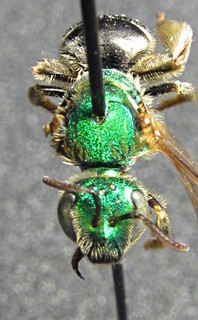
Joshua Thomas · 9
Agapostemon virescens, female, face |
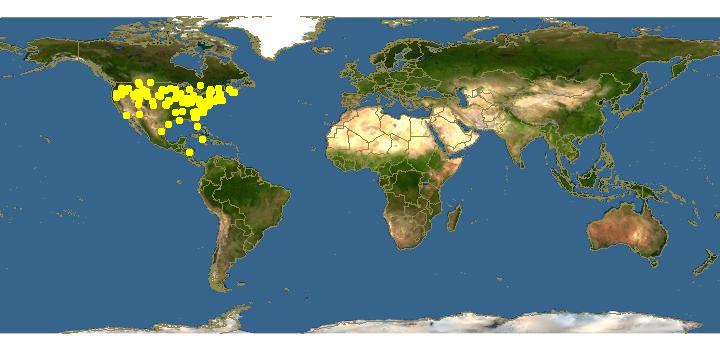
Click on map for details about points.
|
80x5 -
240x3 -
240x4 -
320x1 -
320x2 -
320x3 -
640x1 -
640x2
Set display option above.
Click on
images to enlarge. |
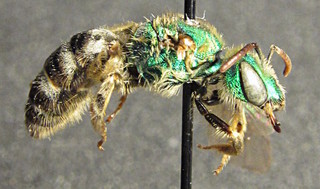
Joshua Thomas · 9
Agapostemon virescens, female, side |
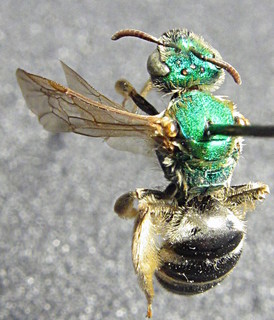
Joshua Thomas · 9
Agapostemon virescens, female, top left |
|
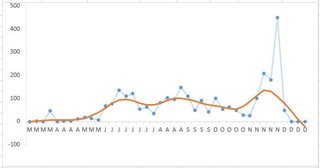
© Copyright source/photographer
· 9
Agapostemon virescens, Mid-Atlantic Phenology |
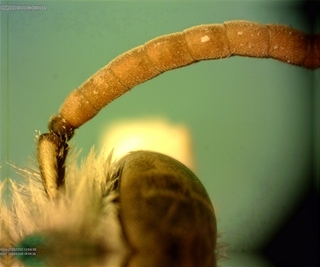
Deana M. Crumbling · 9
Agapostemon virescens, male, antennal scape |
|
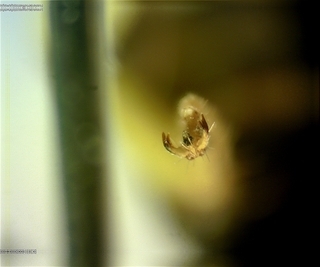
Deana M. Crumbling · 9
Agapostemon virescens, male, arolium |
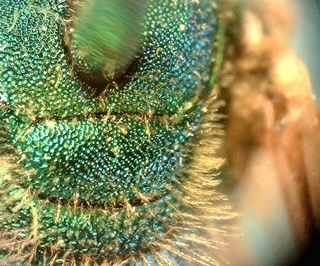
Deana M. Crumbling · 9
Agapostemon virescens, male dorsal thorax |
|
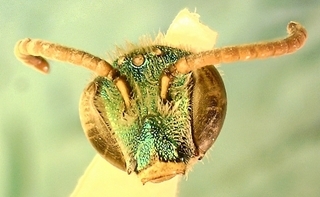
Deana M. Crumbling · 9
Agapostemon virescens, male face |
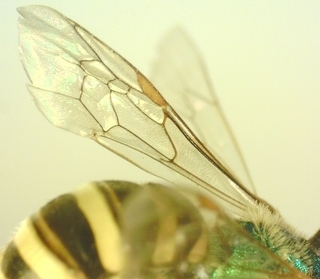
Deana M. Crumbling · 9
Agapostemon virescens, male, forewing basal vein |
|
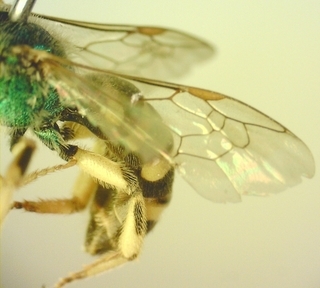
Deana M. Crumbling · 9
Agapostemon virescens, male, hind femur-side view forewing |
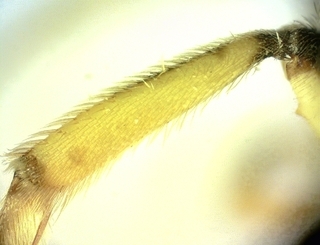
Deana M. Crumbling · 9
Agapostemon virescens, male, hind inside tibia |
|
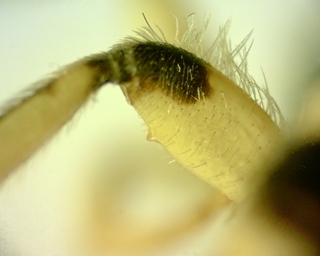
Deana M. Crumbling · 9
Agapostemon virescens, male inside aspect hind femur |
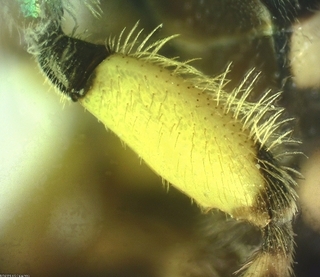
Deana M. Crumbling · 9
Agapostemon virescens, male inside proximal hind femur |
|
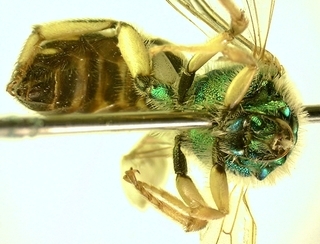
Deana M. Crumbling · 9
Agapostemon virescens, male legs |
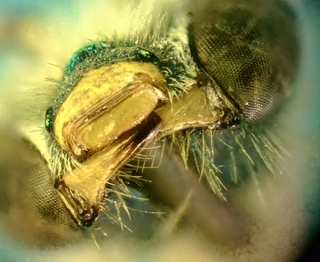
Deana M. Crumbling · 9
Agapostemon virescens, Male, mandibles |
|
Overview |
Reprinted with permission from: Mitchell, T.B. 1960 Bees of the Eastern United States. North Carolina Agricultural Experiment Station Technical Bulletin No. 141.
FEMALE—Length 11 mm.; head and thorax brilliant blue-green, abdomen piceous to black; mandibles testaceous, becoming reddish-piceous apically; apical third of clypeus blackish, base green, punctures well separated on the blackened part, close and rather fine on the basal, greenish portion; supraclypeal area shining, finely and rather sparsely but deeply punctate; face above antennae finely and densely rugose, becoming rather coarsely reticulate laterally and on vertex; cheeks coarsely striate; pubescence very pale yellowish dorsally on head and thorax, becoming more whitish below, but a few dark, inconspicuous hairs on dorsum of thorax; scutum distinctly but very finely and closely punctate over posterior middle, becoming densely rugose laterally and anteriorly; scutellum very finely and closely punctate anteriorly and in midline, somewhat shining on each side, punctures rather coarse and close laterally and posteriorly; pleura coarsely reticulate anteriorly, becoming rather finely so posteriorly, metapleura rather finely striate; dorsal area of propodeum finely rugoso-striate, becoming rather coarsely striate at extreme sides, lateral faces finely striate, posterior face with oblique, irregular, radiating striae on each side; entire legs, including coxa, piceous to black; tegulae brownish-yellow except for an inner greenish spot; wings subhyaline, veins and stigma brownish testaceous; abdominal terga quite closely but very minutely punctate, 2-5 with conspicuous, whitish, basal, tomentose fasciae, pubescence of discs otherwise obscure, subappressed, more fuscous.
MALE—Length 10 mm.; head and thorax brilliant blue-green, abdomen piceous, with yellow, basal bands; mandibles yellow, with ferruginous tips; labrum and apical margin of clypeus yellow, basal portion of clypeus green, very finely and closely but rather irregularly punctate, the apical yellow portion more coarsely so; supraclypeal area strongly protuberant, finely rugoso-punctate; face above antennae densely rugoso-punctate, becoming rather coarsely reticulate on vertex; cheeks rather finely and irregularly striate; scape yellow anteriorly, flagellum brownish-testaceous beneath, becoming piceous above; pubescence pale yellow on head and thorax above, becoming more whitish below; scutum densely and very finely punctate near center posteriorly, becoming more rugose laterally and anteriorly, scutellum more shining, finely and quite closely punctate anteriorly, becoming somewhat more coarsely so laterally and posteriorly; pleura coarsely reticulate anteriorly, becoming finely so posteriorly, metapleura irregularly striate; dorsal area of propodeum reticulate medially, becoming somewhat more regularly striate laterally, lateral faces irregularly striate to reticulate, posterior face irregularly reticulate; tegulae yellowish; wings nearly hyaline, veins and stigma brownish testaceous; coxa greenish in large part, trochanters black, legs otherwise largely yellow, but front and mid femora with basal, piceous blotches, hind femur with a small, apical blotch, mid and hind tibiae each with a narrow, posterior, piceous blotch; hind femora slender, with a ventral, subapical tubercle; basal tergum black basally and apically, with a rather narrow, yellow, median, transverse band, 2-5 with basal yellow bands, piceous discs very finely and closely punctate, pubescence of basal tergum entirely pale yellow, that on yellow areas of the following terga pale, that on the blacker discs subappressed, short and inconspicuous but largely piceous, that on 5 and 6 somewhat longer and pale in general; abdominal sterna 3 and 4 flattened and simple, 6 with a median, longitudinal, low ridge; ventral lobe of gonocoxite expansive, rounded, with an apical fringe; gonostyli with a slender, apical stylus, the tip of which is somewhat curved, with broad, median, dorsal and ventral lobes, the basal lobe inconspicuous, subcontiguous with the dorsal median lobe; penis valves very slightly grooved medially.
DISTRIBUTION—Washington and British Columbia to Quebec and Maine, south to Texas and Florida; April to October.
FLOWER RECORDS—Cirsium, Eupatorium, Gaillardia, Helianthus, Hibiscus, Malva, Oenothera, Pentstemon, Potentilla, Rosa, Salva, Sedum, Solidago, Stellaria, Taraxacum, Vernonia, Veronica and Vicia. Robertson (1929) records this species (as Agapostemon viridulus) on the following additional hosts: Aster, Bidens, Blephilia, Brauneria, Camassia, Castalia, Cephalanthus, Convolvulus, Coreopsis, Cornus, Dianthera, Diospyros, Dipsacus, Erigeron, Geranium, Helenium, Hypericum, Ipomoea, Krigia, Liatris, Linaria, Lippia, Lobelia, Lythrum, Melilotus, Nepeta, Oxalis, Petalostemon, Ptelea, Rhus, Rubus, Rudbeckia, Ruellia, Sagittaria, Scrophularia, Silphium, Stachys, Teucrium, Tradescantia, Trifolium, Verbascum, Verbena and Verbesina.
|
|
|
Identification |
Extracted from: Roberts, 1973. Bees of Northwestern America: AGAPOSTEMON. Agricultural Experimental Station. Oregon State University.
Synonymy: Andrena virescens Fabricius, 1775; Andrena nigricornis
Fabricius, 1793; Halictus dimidiatus Lepeletier, 1841; Halictus tricolor
Lepeletier, 1841; Agapostemon bicolor Robertson, 1893.
Diagnosis. The male of this species has a bright metallic green head
and thorax, and a metasoma banded with black and yellow. It may be
distinguished from males of A. coloradinus by the absence of a long brown
or black streak on the posterior surface of its hind femur. The male of A.
virescens may be distinguished from those of A. femoratus, A. melliventris,
A. texanus, and A. angelicus by the depression and medial ridge on
the apical half of its last visible (sixth) metasomal sternum (Fig. 9).
The female of this species has a bright metallic green head and
thorax, and a black metasoma banded with short, dense, white hair. The female of A. virescens may be distinguished from females of A. coloradinus
by its hyaline wings, coarse genal striac (2-3 per 0.25 min) (Figs. 10,
11) and largely yellow mandibles. It may be distinguished from those
females of A. nielliventris having black metasoma by the lack of yellow
on its clypeus.
Distribution. This species is common in the northern United States
and southern Canada where it occurs from coast to coast (Fig. 19). It
occurs as far south as the Gulf Coast but is rare in that region.
Biology. Little has been published on the biology of this species. Felt
(1928) reported a large nesting aggregation of A. virescens (given as
Halictus virescens) damaging a lawn in Catskill, New York. W. P. Stephen
(pers. comm.) has seen a nesting aggregation in a lawn in Corvallis, Oregon,
and D. H. Janzen (pers. comm.) reports numerous nests in a field near Eugene, Oregon. Thus, it seems that A. virescens is usually, if not
always, aggregatory in its nesting habits.
G. C. Eickwort, W. E. LaBerge, and \V. P. Stephen (pers. comm.)
also have observed more than one female per nest. In addition to multiple
occupancy of a single burrow, N1'. P. Stephen reports that A. virescens
females, which seemed to be in a state of diapause, shared their burrow
with bees of the parasitic genus Sphecodes which also seemed to be in
diapause. On August 5-7 a nest of A. virescens was observed and excavated by
the author in Moscow, Idaho (Fig. 20). According to Dr. NV. F. Barr, in
whose garden the nests were situated, there had been a small aggregation
of active nests earlier in the summer but by August 5 only two nests were
still open. One day was spent observing the nest entrances. In late morning and
early afternoon two males and two females left each burrow, returning
from one to three hours later. During their absence other females occasionally
appeared in the burrow entrances. Their action could hardly
be considered "guarding" because the slightest movement, even the passage
of a butterfly, was enough to cause their disappearance for as long
as an hour. In no other species of Agapostemon are males known to return to occupied burrows once they have emerged.
Plateaux-Quenu (1959) reports that females of Lasioglossum marginatum
(given as Halictus marginatus) occupy their own nests during
the spring. During the summer the nest entrances are closed but in the
fall males emerge from the nests, forage, and return to the nests to mate
with the females. The males then die but the females overwinter in the renests.
Perhaps a similar phenomenon occurs in A. virescens.
Before excavation, the burrows were filled with plastic.' The result
was a tough, permanent, transparent replica of the burrow system. In
these respects, the use of plastic is far more satisfactory than the commonly
employed plaster of Paris method.
One of the two active A. virescens nests had no tumulus or turret but
the other had a small turret 4 mm high with walls 3 mm thick. This turret
probably was the consolidated remnant of a much larger tumulus which
had been destroyed by wind. The branched main burrow was 7.0±- .8 mm
in diameter and the laterals (not illustrated) were about 5.3 mm. There
was no discernible constriction of the nest entrance, but some of the
branch burrows were slightly constricted where they joined the main burrow.
Owing to the complexity of the nest and its proximity to other nests,
it was nearly impossible to trace the earth-filled laterals back to the main burrows, but most of the cells were several centimeters from the main
burrows. Thus it seems that in the construction of laterals much longer
than the lengths of the cells, A. virescens is similar to other species of
Agapostemon.
During excavation, numerous adults were found in a state of torpor
in their natal cells. In other Agapostemon species the adults emerge from
their natal cells within 48 hours after their final molt. Many cells were
uncovered in the course of excavation and the contents of 158 were pre served-69 were female pupae and adults, 57 male pupae and adults, and
32 were late instar larvae or prepupae.
Especially noteworthy was the occurrence of linear pairs of cells at
the ends of many of the laterals. In each of the 12 pairs examined (many
others were accidentally destroyed in the course of excavation), the distal
cell always contained a female and the proximal cell a male. One lateral precontained
two male cells and a distal female cell. Related genera such
as Ruizantheda (but never the genera allied to Halictus or Augochlora )
construct long strings of linearly arranged cells. Daly and Wille (in Sakagami
and Michener, 1962), describe a nest of A. nasutus in which only
linear pairs of cells were found. As in A. virescens, the distal cell always
contained a female and the proximal cell a male. In extensive observations
of A. nasutus, Eickwort and Eickwort did not find such linear pairs
of cells. Perhaps the construction of cell pairs is facultative in A. nasutus
as it seems to be in A. virescens.
But for the paired cells and the presence of males, the A. virescens
nest excavated was similar to those of A. nasutus described by Eickwort
and Eickwort (1969) in that it had many main branches occupied by
many bees. As none of the A. virescens females were reproductively active
at the time the nest was excavated, it was not determined whether this
species is social or, more likely, merely communal like A. nasutus.
Extracted from: Roberts, 1972. REVISION OF THE BEE GENUS AGAPOSTEMON. Agricultural Experimental Station. The University of Kansas.
The synonymy of Andrena nigricornis Fabricius and Halictus dimidiatus
Lepeletier with Andrena virescens Fabricius is based on their descriptions.
C. D. Michener examined the type of A. virescens in the British Museum.
G. C. Eickwort examined the type of Agapostemon bicolor in Urbana,
Illinois, and confirmed Robertson's synonymy (1895) of this species with
A. virescens. 1 have examined the type of hi. tricolor and it is a synonym
of A. virescens, not A. radiatus as stated by Sandhouse (1936).
Van der Vecht (1959) suggests that Apis sericea Forster (1771) may be
a senior synonym of A. virescens, but the description given by Forster does
not warrant such a conclusion (cf . Nomina Dubia) .
Distribution (Fig. 30). Specimens have been collected as far east as
Penobscot Co. in central Maine; as far west as Coos Co. on the Oregon
Coast; as far south as Hernando Co. on the central western coast of Florida;
and as far north as Vernon, British Columbia. This distribution is unusual
inasmuch as it is wide, ranging from coast to coast, yet this species is com mon only from about 37° to 47° North latitude. In the northwestern part
of the range (British Columbia and Alberta) males have been collected from
August through October, and females from April through August and in
October. In the central part of the range (Nebraska) males have been
collected from July through October, and females from May through October.
In the southeastern part of the range (Virginia, Tennessee, North Carolina
and Georgia) males have been collected from June through September and
in November, and females from May through August and in October.
Although A. virescens occurs primarily at elevations of less than 2,000 ft.
(610 m), I have seen specimens from as high as 4,000 ft. (1,219 m) on
Middle Mountain, Virginia; 6,900 ft. (2,103 m) near Boulder, Colorado; and
7,000 ft. (2,134 m) near Salt Lake City, Utah.
Diagnosis. The male may be distinguished from many other North
American species by the lack of yellow maculations on its brown to brown-
black sterna 5-6, by its medial ridge on the apical ! /2 of sternum 6 (last
visible sternum), and by its gonostylus (Fig. 183); from A. coloradinus and
A. tyleri by the restriction of brown to brown-black areas on the posterior
surface of its hind leg to basal and apical regions of femur and tibia, and
by its lack of a prominent dorsal crest on its penis valve. The females may
be distinguished from other species occurring north of Mexico by its black
metasomal terga and the lack of yellow on its clypeus; from females of A.
coloradinus and A. tyleri by the coarser carinae on its gena (2-3 per 0.25
mm in A. virescens, 5-6 per 0.25 mm in A. coloradinus and A. tyleri), and
its largely yellow mandibles (amber to brown in A. coloradinus and dark
brown in A. tyleri).
Description
male (Figs. 97-98, 158, 183, 197)
General coloration of head and mesosoma bright metallic green, meta-
soma with black and yellow bands. Head (Figs. 97-98): pubescence white
becoming yellowish to pale amber on vertex. (1) Labrum as in A. texanus
but slightly blunter at apex. (2) Clypeus with medium size, shallow,
scattered punctures on yellow portion, becoming more dense and slightly
larger above. (3) Interocular area with large deep contiguous punctures
below ocelli, becoming rugose and more shallowly sculptured below; supra-
clypeal protuberance shallowly rugose to punctate with few faint horizontal
rugae. (4) Vertex with deep contiguous punctures anteriorly, becoming
more finely punctate laterally, and coarsely but shallowly rugose posteriorly
and between ocelli. (5) Gena with numerous short, parallel, subcontiguous
carinae extending dorso-laterally from antero-ventral margin. (6) Malar
area bright yellow to pale amber; short. (7) Mandible bright yellow with
apical V3 ferruginous. (8) Antenna brown to brown-black above with shiny
pale area on apical l / 2 of apical flagellomere; flagellum pale amber to brown below; and underside of scape and pedicel yellow to largely black with yellow
apically. Mesosoma: pubescence white, becoming pale amber to yel-
lowish on mesonotum and metanotum. (9) Pronotum with lateral angle
and posterior lobe neither very rounded nor acute; postero-lateral area with
large, broad, low, vertical ridge just anterior to numerous very fine and
faint carinulae. (10) Mesoscuhim with fine contiguous punctures becoming
finely rugose anteriorly and antero-laterally. (11) Mesoscutellum with punc-
tures like those of mesoscutum but somewhat larger and less dense (especially
laterally). (12) Metanotum finely and deeply rugose. (13) Mesepisternum
coarsely rugose anteriorly, becoming finely rugose posteriorly. (14) Metepi-
stcrnum with irregular horizontal carinae, anastomosing so as to appear
largely rugose on some specimens. (15) Propodeum with distinct propodeal
carina; propodeal shield coarsely and shallowly rugose; dorsal area coarsely
rugose, postero-lateral area moderately rugose, becoming finely rugose to
coarsely punctate antero-laterally. (16) Wing clear to transparent amber
with apical regions slightly darkened. Radial vein dark brown, stigma and
remaining veins pale brown. (17) Tegula pale transparent amber with
green tints antero-basally, short transverse yellow band on anterior area
curving rearward and almost reaching distal margin; posterior margin
yellow. (18) Fore leg yellow with coxa bright metallic green; trochanter
dark brown; femur with brown basally and postero-dorsally on basal x / 2 of
tibia. Pubescence white to pale yellow. (19) Middle leg like fore leg but
with only faint green tints on coxa and with brown streak postero-dorsally
on basal %-% of tibia. Pubescence white to pale yellow. (20) Hind leg
(Fig. 158) with coxa bright metallic green; trochanter brown (sometimes
with faint metallic tints); femur yellow with brown at base and apex;
tibia yellow with brown at base (and sometimes at apex) and brown streak
centrally on antero-dorsal surface. Pubescence white to pale yellow. Meta-
soma: (21) Terga brown to brown-black with yellow bands on basal
halves of terga 2-5 and narrow yellow band centrally on tergum 1; pubes-
cence white, short and appressed on dorsal portions of terga 1-4, moderate
length elsewhere. (22) Sterna brown to brown-black with yellow baso-
laterally on sterna 2-4 (often hidden by overlapping sterna), and sternum 1
with metallic tints basally; apical ! / 2 of sternum 6 with median ridge in
shallow depression. Pubescence white and moderately long on exposed
areas. (23) Genitalia (Figs. 183, 197) with dorsal crest of penis valve
rounded and broad, not prominent as in most other species; ventral lobes
of moderate size and distally fringed with hairs.
female (Figs. 28, 53-54)
General coloration of head and mesosoma bright metallic green to
blue-green, metasoma black with white hair bands. Head (Figs. 53-54) : pubescence white, becoming faintly yellowish at vertex (and on
interocular area of some specimens). (1) Labium as in A. texanus. (2)
Clypeus with large scattered punctures below, becoming contiguous above.
(3) Interocular area with deep, medium sized punctures above, becoming
deeply but finely rugose below. (4) Vertex with deep, small, contiguous
punctures anteriorly, finer and shallower laterally and becoming finely rugose
posteriorly; area between ocelli finely rugose to punctate. (5) Gena with
moderately fine (2-3 per 0.25 mm) parallel carinae extending postero-dorsally
from antero-ventral margin. (6) Malar area amber to ferruginous and very
short, almost absent. (7) Mandible yellow or rarely very pale amber; with
apical Yi- 1 /^ ferruginous. (8) Antenna dark brown to brown-black with
underside of flagellum slightly paler brown. Mesosoma: pubescence white,
becoming pale amber to slightly fuliginous on mesonotum and meta-
notum. (9) Pronotum with lateral angle and posterior lobe neither very
rounded nor acute; numerous very faint parallel carinulae extending antero-
dorsally from postero-ventral area. (10) Mesoscutum with deep, medium
sized, contiguous punctures becoming rugose anteriorly and antero-laterally.
(11) Mesoscutellum with fine contiguous punctures medially, becoming
large and separated by as much as 2-3 times their diameters laterally. (12)
Metanotum rugulose. (13) Mesepisternum coarsely rugose, only very slightly
finer rugae posteriorly. (14) Metepisternum with moderately coarse carinae
regular and parallel anteriorly, irregular and anastomosing posteriorly. (15)
Propodeum with prominent propodeal carina; propodeal shield with nu-
merous weak carinae extending laterally and slightly dorsally from median
groove; dorsal area with irregularly anastomosing carinae extending postero-
laterally from anterior margin; lateral area with anastomosing horizontal
rugae coarse posteriorly, becoming fine anteriorly. (16) Wing as in $ .
(17) Tegula as in $ but slightly darker. (18-20) Fore, middle and hind legs
brown to brown-black with yellow dorsally at apex of femur and base of tibia
of fore and middle legs; dorsal surface of hind coxa with strong metallic
tints; pubescence white to amber, becoming fuliginous apically on dorsal
surface of middle leg and brown-black basally on antero-dorsal surface of
hind leg. Metasoma: (21) Terga black; white tomentose hair bands
basally on terga 2-4 and centrally on tergum 1 (often broadly interrupted
medially); pubescence anteriorly on tergum 1 and laterally on terga 1-5
white and moderately long; pubescence dorsally on terga 5-6 moderately long
and brown to black. (22) Sterna brown to brown-black with long, scattered
white hairs on exposed areas.
|
|
|
Names | |
|
|
| Supported by | |
|
Following served from Steve Scott, Bugguide, bugguide.net |
Top | See original context
|
Following served from Image from Cedar Creek Natural History Area |
Top | See original context
Updated: 2024-04-26 13:36:27 gmt
|

